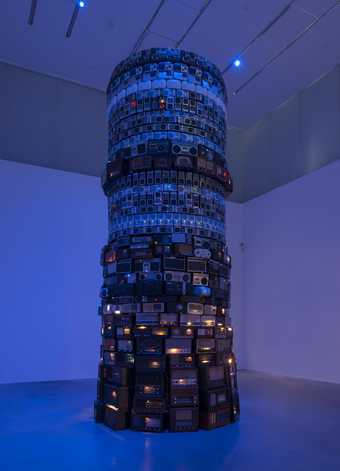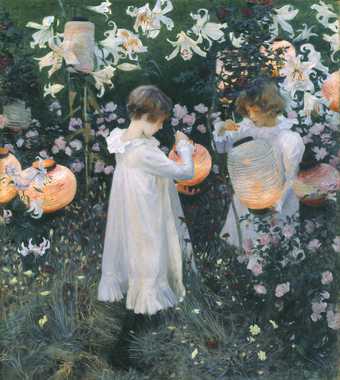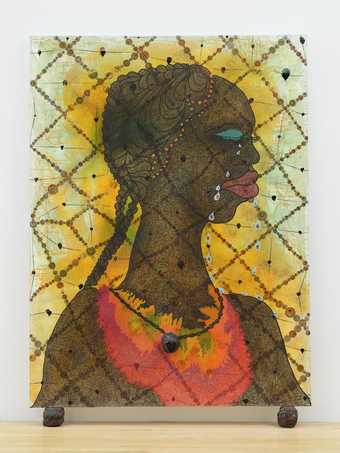Press play and discover the story behind Loveday and Ann: Two Women with a Basket of Flowers by Frances Hodgkins. Hear a detailed description of the artwork and learn more about how the artist made the work.
Frances Hodgkins Loveday and Ann: Two Women with a Basket of Flowers 1915
This is an audio description of Loveday and Ann: Two Women with a Basket of Flowers, painted by Frances Hodgkins in 1915.
The work is painted in oil on canvas and measures around 67 centimetres - or just over 2 feet - square.
Loveday and Ann were two young women, daughters of fishermen from St Ives in Cornwall, where New Zealand-born Hodgkins was living in 1915. They are seen three-quarter length, sitting on a small, centrally placed, high-backed sofa in an airy room.
We don’t know which of the two figures is Loveday and which is Ann. However, following the direction of the title perhaps we can place Loveday on the left and Ann on the right.
The sofa is covered in green and white, vertically striped fabric. Ann faces forward but Loveday perches sideways on, facing to the right and appearing nearer to us. She is partially hidden by the chintz-covered arc of part of the back of an armchair. This makes it difficult to be sure if she’s sitting on the sofa or on a chair beside it. Between the women is a large basket, packed with bunches of flowers. Their colours are brilliant - red, deep purplish blue and white, with large black centres. The bright flowers capture attention, standing out against the subtle colours around them, against the patterns and textures of different fabrics, of wicker baskets and petals, skin and hair painted with soft contours and blended tones.
The two women are almost caricatures and their expressions open to interpretation. Ann beams a broad smile at Loveday. Her cheeks and lips are full and fleshy. Her eyes are squinted and almost lost in the striking green-blue shadows that cover her face and long neck. Her hair is hidden beneath a rust-red scarf tied tightly under a large, drooping black hat. It looks like an outsize beret. A gold earring peeks out from beneath, on her right ear. She wears a white top, perhaps a faintly patterned blouse, and a large black skirt on which she lays her left arm, next to the basket of flowers. Her hand is painted in grey, blue and red-brown, with disproportionately long fingers and exaggerated fingertips.
Seated on the left, Loveday leans back into her chair. Her head is turned away from her friend so she is seen in three-quarter view. She is wrapped in an indistinct, filmy beige fabric with a faint but busy pattern of grey, tangled lines. Her face is slim, with a pointed chin, a small pursed mouth and finely arched brows. A brown ribbon ties her smooth dark hair and stands out above her head. She looks downwards towards the bottom right of the painting, her gaze extending beyond the boundaries of the frame. Loveday’s right arm also rests on her lap. It appears flat and formless, but her hand, like Ann’s, is prominent. The fingers are folded and the knuckles outlined in silver-grey, almost like metallic scales. Both women may have worked in the St Ives fishing industry, as did many women in fishing families. Perhaps the artist depicts these exaggerated hands as a symbol of daily life.
On either side of the background is a section of mauve, rust-red and grey swirling paint. This perhaps represents wallpaper or wall coverings hung in the artist’s studio space. A single green and white striped curtain, matching the sofa, hangs behind Ann’s head. Between the women is an area that appears to show pale, misty flowers climbing up a white wall – perhaps representing a window with a view beyond. But if this is a garden, it’s imaginary. The picture was painted in Frances Hodgkins’s studio, 7 Porthmeor Studios, St Ives. The studio is close to the beach but with no garden-view.
Hodgkins came to Cornwall from New Zealand in 1901 and mainly produced watercolours. Even when working with oil paint, Hodgkins retains the brightness and fluid line of her works in watercolour. Moffat Lindner, also a successful St Ives painter, saw the artist working on the picture. He purchased it from her even before it was finished. While in Cornwall, and also during stays in Paris, Hodgkins developed her distinctive representative style and characteristic use of colour. At her death in 1947 she was considered one of New Zealand’s – and Britain’s - leading modern artists.
This audio description was written by VocalEyes describer Bridget Crowley and recorded by Jo Bowis.



